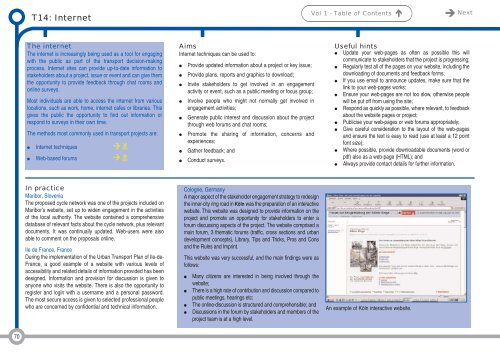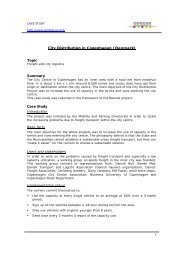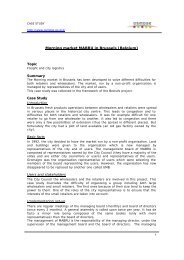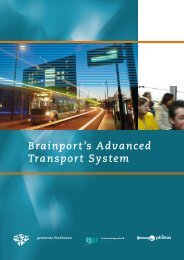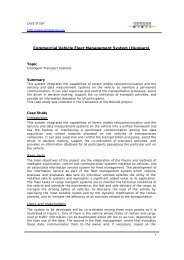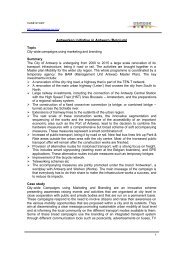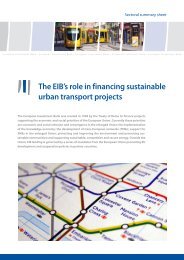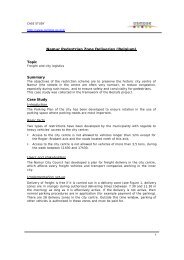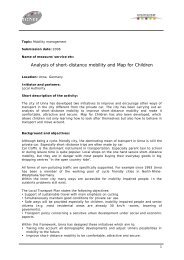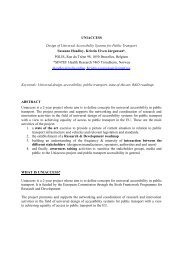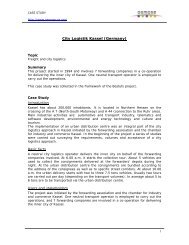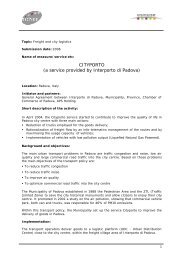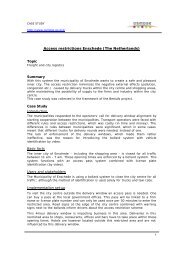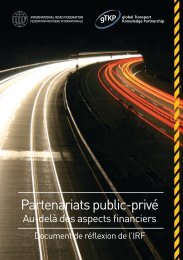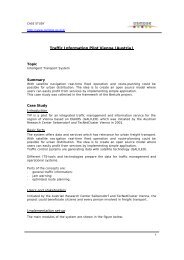Successful transport decision-making - Osmose
Successful transport decision-making - Osmose
Successful transport decision-making - Osmose
You also want an ePaper? Increase the reach of your titles
YUMPU automatically turns print PDFs into web optimized ePapers that Google loves.
T14: Internet<br />
Vol 1 - Table of Contents <br />
Next<br />
The internet<br />
The internet is increasingly being used as a tool for engaging<br />
with the public as part of the <strong>transport</strong> <strong>decision</strong>-<strong>making</strong><br />
process. Internet sites can provide up-to-date information to<br />
stakeholders about a project, issue or event and can give them<br />
the opportunity to provide feedback through chat rooms and<br />
online surveys.<br />
Most individuals are able to access the internet from various<br />
locations, such as work, home, internet cafes or libraries. This<br />
gives the public the opportunity to find out information or<br />
respond to surveys in their own time.<br />
The methods most commonly used in <strong>transport</strong> projects are:<br />
Internet techniques <br />
Web-based forums <br />
Aims<br />
Internet techniques can be used to:<br />
<br />
<br />
<br />
<br />
<br />
<br />
<br />
<br />
Provide updated information about a project or key issue;<br />
Provide plans, reports and graphics to download;<br />
Invite stakeholders to get involved in an engagement<br />
activity or event, such as a public meeting or focus group;<br />
Involve people who might not normally get involved in<br />
engagement activities;<br />
Generate public interest and discussion about the project<br />
through web forums and chat rooms;<br />
Promote the sharing of information, concerns and<br />
experiences;<br />
Gather feedback; and<br />
Conduct surveys.<br />
Useful hints<br />
Update your web-pages as often as possible this will<br />
communicate to stakeholders that the project is progressing;<br />
Regularly test all of the pages on your website, including the<br />
downloading of documents and feedback forms;<br />
If you use email to announce updates, make sure that the<br />
link to your web-pages works;<br />
Ensure your web-pages are not too slow, otherwise people<br />
will be put off from using the site;<br />
Respond as quickly as possible, where relevant, to feedback<br />
about the website pages or project;<br />
Publicise your web-pages or web forums appropriately;<br />
Give careful consideration to the layout of the web-pages<br />
and ensure the text is easy to read (use at least a 12 point<br />
font size);<br />
Where possible, provide downloadable documents (word or<br />
pdf) also as a web-page (HTML); and<br />
Always provide contact details for further information.<br />
In practice<br />
Maribor, Slovenia<br />
The proposed cycle network was one of the projects included on<br />
Maribor's website, set up to widen engagement in the activities<br />
of the local authority. The website contained a comprehensive<br />
database of relevant facts about the cycle network, plus relevant<br />
documents. It was continually updated. Web-users were also<br />
able to comment on the proposals online.<br />
Ile de France, France<br />
During the implementation of the Urban Transport Plan of Ile-de-<br />
France, a good example of a website with various levels of<br />
accessibility and related details of information provided has been<br />
designed. Information and provision for discussion is given to<br />
anyone who visits the website. There is also the opportunity to<br />
register and login with a username and a personal password.<br />
The most secure access is given to selected professional people<br />
who are concerned by confidential and technical information.<br />
Cologne, Germany<br />
A major aspect of the stakeholder engagement strategy to redesign<br />
the inner-city ring road in Köln was the preparation of an interactive<br />
website. This website was designed to provide information on the<br />
project and promote an opportunity for stakeholders to enter a<br />
forum discussing aspects of the project. The website comprised a<br />
main forum, 3 thematic forums (traffic, cross sections and urban<br />
development concepts), Library, Tips and Tricks, Pros and Cons<br />
and the Rules and Imprint.<br />
This website was very successful, and the main findings were as<br />
follows:<br />
<br />
<br />
<br />
<br />
Many citizens are interested in being involved through the<br />
website;<br />
There is a high rate of contribution and discussion compared to<br />
public meetings, hearings etc;<br />
The online-discussion is structured and comprehensible; and<br />
Discussions in the forum by stakeholders and members of the<br />
project team is at a high level.<br />
An example of Köln interactive website.<br />
70


